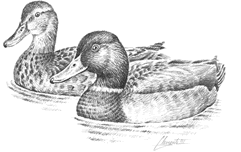Post Oak Savannah and Blackland Prairie Wildlife Management
Winter Ecology of Mallards

Mallards
The biological and ecological interactions of reproduction in mallards is a complex web of events interlocking external and internal occurrences. Truly, this is a year-round cycle. Environmental factors drive the changes in the birds. Ensuing stages in the life cycle of the ducks are driven by hormones produced as a result of these environmental changes. It is a story of the union of biology and ecology.
As young mallards fledge, adults complete summer molts, although at somewhat different times. This can be considered a brief period of neutrality in the reproductive cycle. Evidence of this condition can be seen in the prosaic fall plumages. Adult drake mallards arriving on the wintering grounds have the typical feather pattern described above. Hens are rich brown above while the brown color on breasts contrasts distinctly with grayish-white on bellies. The orange colors of legs, feet, and bills are somewhat subdued. Later, however, changes in appearance will occur which are necessary for important events in the breeding cycle.
In this fall dress, adult mallards begin the early phases of selecting mates. The pace of establishing pair-bonds gradually intensifies as the wintering period progresses. Early courtship identifies prospective mates. However, completion of bonds that result in mated pairs depends on certain environmental factors that guide changes in the birds bodies and behavior. This is a classic ecological relationship. Habitat is the key. The reproductive biology of mallards is closely tied to their habitats.
Many mallards achieve pair-bonding in bottomland hardwood forests in the South. Winter sex ratio data of mallards in the Central Flyway may suggest these birds come to these locales for that function. Survey data indicate that the proportion of males to females is about 1:1 in Texas while flocks wintering further north may be as much as 7:1 in favor of males. Perhaps the balanced sex ratios more likely favor pair establishment. Certainly, high quality habitat in bottomland hardwood forests provides life requisites necessary for sucessful pair-bonding and subsequent events.
In late winter, pre-breeding adults begin a molt of their body feathers. Drakes develop striking colors. They look as if they had been polished. Hens change into feather patterns better suited to camouflage on the nesting grounds. This is noticeable in more streaked body plumage. The whitish bellies in hens also become brownish and streaked. To produce these new feathers, mallards must obtain high-protein diets available in abundant invertebrates found in flooded bottomland hardwood forests. The leaf detritus decaying on the wet forest floor provides the food base for these invertebrate population explosions. In addition to the appearance of feather patterns, these dietary changes can be seen in the vivid colors that become evident in legs, feet, and bills. The consumption of invertebrates results in bright orange colors in soft tissues. Therefore, the "red-legged mallards from Kansas" simply are winter-resident birds preparing for the breeding season by feeding heavily on invertebrates.
These plumage changes are vital to production. Without abundant invertebrate
foods, hens cannot promptly undergo the late winter molt. Unless hens complete
these late winter molts, they will not become mated. Obviously, if they are
not mated, they will not produce and incubate eggs on the nesting grounds.
No ducklings will be produced and the fall flight will be reduced. The overbanking
of rivers and streams and direct rainfall during winter months is critical
for shallow flooding of forested wetlands. Without sufficient water, the habitat
functions vital for supporting invertebrates will not develop. Thus, the circle
linking mallards into this process clearly would not close.
In this way, the conditions in winter habitats are connected to the success
of production on the breeding grounds.
As these molts occur, the late winter behavior of mallards also changes. To acquire adequate invertebrate foods, hens must spend much time feeding. Accordingly, the typical fall schedule of feeding flights early and late each day (with mid-day loafing) is replaced with all-day feeding in flooded bottomland forests. The birds seclude themselves in pairs. Drakes serve as sentinels while hens feed. The pair-bonds intensify. The biology/ecology linkage tightens.
With successful completion of this body molt, mallards are fully paired and depart into northward migration. Therefore, upon immediate arrival on the nesting grounds, they rapidly progress into egg-laying, incubation, and brood-rearing.
Consequently, less than ideal habitat conditions on the wintering grounds can result in reduced reproduction on the breeding grounds. Thus, attention to habitat quality and quantity must be viewed with the "big picture" in mind. All habitats that mallards use are important and are worthy of conservation actions
Links to other Waterfowl and Wetland Conservation pages can be found on the sidebar.
 (
(